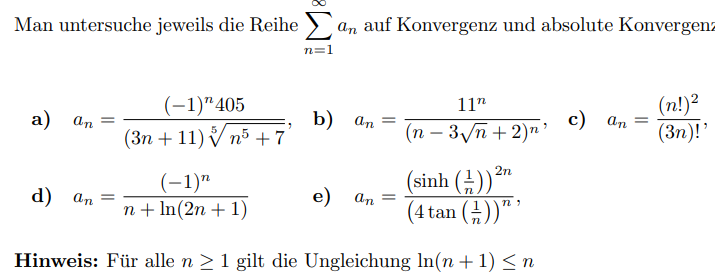Aufgabe:

Man untersuche jeweils die Reihe \( \sum \limits_{n=1}^{\infty} a_{n} \) auf Konvergenz und absolute Konvergenz.
$$ \textrm{a)}\quad a_{n}=\frac{(-1)^{n} 405}{(3 n+11) \sqrt[5]{n^{5}+7}} $$ $$ \textrm{b)} \quad a_{n}=\frac{11^{n}}{(n-3 \sqrt{n}+2)^{n}} $$ $$ \textrm{c)} \quad a_{n}=\frac{(n!)^{2}}{(3 n)!} $$ $$ \textrm{d)} \quad a_{n}=\frac{(-1)^{n}}{n+\ln (2 n+1)} $$ $$ \textrm{e)} \quad a_{n}=\frac{\left(\sinh \left(\frac{1}{n}\right)\right)^{2 n}}{\left(4 \tan \left(\frac{1}{n}\right)\right)^{n}} $$ Hinweis: Für alle \( n \geq 1 \) gilt die Ungleichung \( \ln (n+1) \leq n \)
Bei Aufgabe 23b) startet die Reihe erst ab n=5.
Problem/Ansatz:
Ich habe bei a), b), c) und e) absolut konvergent und bei d) nur bedingt konvergent. Ist das richtig so?